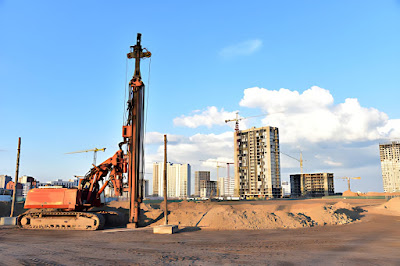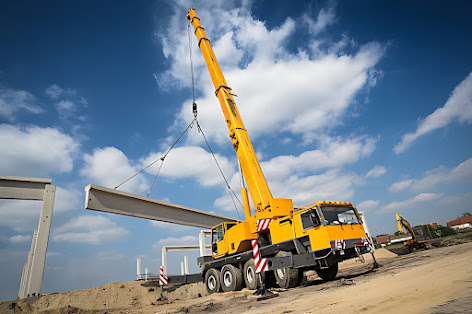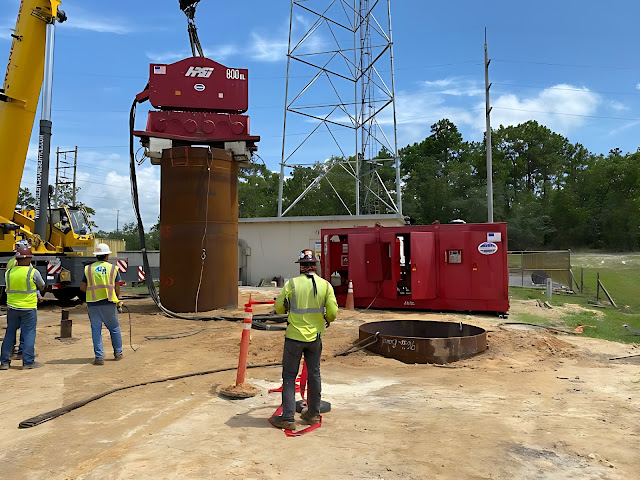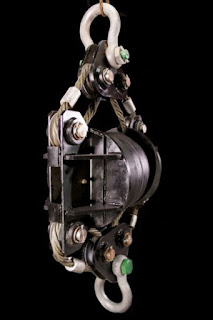The vibratory hammer, also known as a vibratory hammer, is a machine used to drive piles into and out of the ground to build structures such as bridges, harbors, roads, airports, canal works, etc. Building foundations include harbors, bridges, airports, buildings, roads, rails, infrastructure, wind turbines, solar power, walls, and many other foundations. Pipe, sheet, and wooden piles are popular with vibro hammers.
Sound power is the most prominent characteristic of pile hammers equipment. In addition to being very loud, impact hammers use weights to produce impact. Since vibratory hammer drivers do not apply extra force to the ground, they are light and much faster than standard hammer drivers. Therefore, they are more appropriate for urban areas and downtowns.
In contrast to traditional pile drivers that use heavy weights to strike piles, modern pile drivers are quiet and have many advantages.
Among the greatest advantages of vibratory hammers is their ability to drive and extract piles at much faster speeds. To learn more about how it works for excavators, continue reading.
How does a Vibratory hammer work?
The vibratory hammer and vibro driver reduce resistance in the ground by vibrating it and changing its composition. Vibratory piling machines use hydraulic clamps to transfer vertical vibrations to piles. Thus, the pile can be driven or extracted with less force due to the vibrations transferred to the ground, reducing friction between the pile and the ground. By combining the vibrator's weight and centrifugal force, the pile gets driven into the ground.
Workings of Excavator Mounted Vibratory Drivers
Attach the hoses connected to the pressure and return lines of the vibratory pile driver for excavator to the flowmeter. The hoses need to be connected correctly to the port of the flowmeter so that it can be read. By adjusting the flowmeter pressure with the restrictor, you can achieve the exact pressure you need for your vibro. You can achieve the exact flow you need by adjusting the flow with the excavator main pump's adjusting valve.
Excavator and vibrator pressure and return hoses should be fitted with flowmeters. Adjust pressure and flow rate with the excavator main pump's adjustment valve. A drain (D) pressure of less than 8 bar is recommended. To prevent damage to hydraulic motor rod seals, the rain line relief valve releases pressure when the drain pressure exceeds 8 bar.
Preparation of the excavator
A vibration hammer mounted on an excavator
Remove the bucket link pin, pivot pin, and the bucket itself.
The bucket cylinder pin (rod end) and bucket linkage pin (stick) should be removed. The bucket linkage needs to be removed.
Steps for installing a vibro hammer on an excavator
Move the excavator to the location of the vibrator. Lift the vibrator, and support it vertically.
In the area of the bucket pivot, check that the ears of the yoke fit on the excavator stick.
Make sure the yoke pin fits properly in the bucket pivot bore.
Connect the excavator stick to the yoke if all fits are correct.
Turn off the excavator after fully retracting the bucket cylinder.
Hoses connected to bucket cylinders should be disconnected and plugged with proper-size plugs.
Installation of the excavator hoses to the vibrator after removing the plugs (P, R, and D) from the manifold.
The hoses can be bled by loosening the clamp cylinder. As the excavator runs at low speed, slightly move the bucket lever or joystick to close the clamp. Wait until the connection is closed after the oil has flowed from the clamp. If oil flows without air, tighten the connection.
Conclusion
There you have it. Hopefully, you now have all the details about the workings of the Vibratory hammer. At HPSI, we offer high-quality pile hammer equipment for sale at an affordable price.













